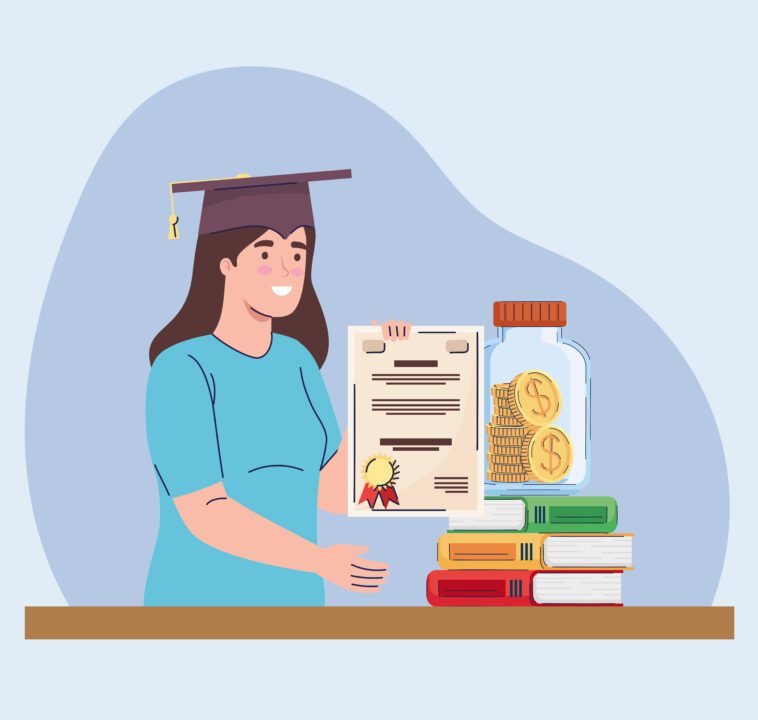There are a variety of student loans to choose from, including private and federal loans. There are also loan options like deferment, forgiveness, and graduated repayment plans. You might be wondering which option is right for you.
Private student loans
Private student loans are a type of loan that is available to students who are in college. These loans are financed by banks and credit unions. These loans are based on the borrower’s credit history and other factors.
Depending on the lender, private student loans can offer a variety of terms and features. Some of these features include fixed or variable interest rates, forbearances, and interest only payments after graduation.
When applying for a private student loan, borrowers should be sure to understand all of the terms and conditions before they sign. They should also check the loan’s repayment schedule and fees. They should then shop around for other loan programs.
Students should also consider a cosigner, which may improve their chances of getting a private student loan. A cosigner can be a parent, relative, or other creditworthy individual. A cosigner accepts the responsibility for the loan if the borrower is late on payments or fails to repay the loan. The cosigner can also help the borrower secure a lower interest rate.
Lenders generally require a borrower to be at least 18 years old. They should also be enrolled at least half time. The borrower has the right to cancel the loan before it is sent to the school. If the loan is sent to the school, the lender will then disburse the funds.
Many private student loans offer discounts to borrowers who agree to make automatic loan payments. Some lenders offer deferred payments, and some offer forbearances in 2 to 3 month increments.
Students can apply for private college loans online or by phone. During the application process, students will fill out basic personal information and choose an interest rate. The loan’s APR will be determined based on the borrower’s credit and the selected repayment option.
Forgiveness
There are many student loan forgiveness programs available in the United States. Each state has its own program, but the majority of these programs are for federal student loans.
The process is not easy. A borrower must prove he or she is eligible. The government must approve the request. This process can be cumbersome and time-consuming, especially for people with severe disabilities.
A good way to qualify for student loan forgiveness is by participating in an income-driven repayment plan. This type of repayment plan is designed to help borrowers pay off their debt more quickly. Depending on the income of the borrower, the monthly payments can be low or high.
Another option is to refinance your private loans. Some lenders offer individual arrangements for severe income reductions. You can also contact your lender to see if refinancing would help you. If you can afford to refinance your loans, you will save money in the long run.
In addition to being eligible for an income-driven repayment plan, you can be a part of the Public Service Loan Forgiveness (PSLF) program. This program forgives the balance of your student loan if you meet certain requirements. To be eligible, you must be employed full-time in a public service position and make at least 30 hours of public service per week.
While the Obama administration offered loan forgiveness to borrowers with more than $30,000 in student debt, the Biden administration has taken a different approach. While they plan to continue the pause in payment of federal student loans through 2022, they are considering an executive action that could wipe away all or most of your student debt.
This plan, according to the White House, will only benefit Americans who earn less than $150,000 a year. In addition to making it harder for low-income families to qualify, the plan would increase the cost of higher education.
Deferment
Deferment of student loans is a form of payment postponement that can be beneficial in certain circumstances. There are different types of deferment and eligibility criteria vary by type of loan and lender.
For students with federal loans, there is usually a limit of twelve months in forbearance. In addition, federal loan holders can request a maximum of 36 months of cumulative deferment.
Private lenders offer similar deferment limits and can also have alternative options. If you are considering deferring your student loan, it is important to contact your lender before you incur any financial or credit risk.
The length of deferment can vary, from six months to several years. Interest will accrue during the time of deferment, but it will not be added to the total amount owed. When repayment resumes, the interest will be added to the loan balance.
The student must be enrolled at least half-time. If he or she is not enrolled, the school will notify the loan servicer.
Deferment of student loans is available for qualified students and is typically for three years. However, the maximum time period depends on the type of loan.
In-school deferment is available for students who are at least half-time. To qualify, the student must have applied for the deferment and submitted the request to the loan servicer.
Deferment is not available for students who are overqualified. Additionally, borrowers with a co-signer may not be eligible.
In addition, a deferment does not affect the credit rating of your co-signer. This is because the co-signer is only responsible for accounts that are non-current. If the loan has been defaulted, the co-signer may be legally responsible.
Some of the types of deferment available include in-school deferment, forbearance and hardship deferment. All of these are options that you should explore before the situation becomes too difficult to handle.
Forbearance
If you’re in a tough situation and struggling to make your student loan payments, you may want to look into forbearance. While it can be helpful, it also comes with a few risks. It’s important to understand how forbearance works and why it’s not a good idea to rely on it for too long.
First, if you’re unsure of whether you qualify for forbearance, you’ll need to check with your lender. Depending on the circumstances, you could be eligible to receive forbearance if you have a valid reason for being in financial hardship. Some common reasons include: illness, a major medical emergency, or loss of a job.
Secondly, there is a three-year cumulative limit on forbearance. You must request forbearance from your lender before it’s too late. This will help protect your credit score.
Third, you’ll have to be willing to pay a qualifying payment. This might be higher than you were expecting. But it’s better than defaulting. Once you resume making your payments, you’ll have a clean slate and be able to start paying off your loans more quickly.
Finally, you’ll have to negotiate your repayment terms with your lender. In some cases, you may have to pay interest during your forbearance period.
In addition, it’s important to keep in mind that forbearance is only a temporary solution. If you miss a few payments, it can damage your credit. Eventually, you’ll have to pay off your student loan. So, if you’re in a financial bind, it’s best to get your loans in order and avoid defaulting. Forbearance is a great way to get your finances in shape, but only if you apply for it before it’s too late.
Graduated repayment plans
A Graduated repayment plan for student loans offers a way to make payments that are lower in the beginning. This can be helpful for recent graduates who are still in school and are not yet earning money. However, this payment strategy is not as beneficial for those who are already in the workforce.
A graduated repayment plan works by making the first payments lower and then gradually increasing the amount of payments in the future. This helps borrowers to get used to the repayment process and manage their budgets more easily.
In order to qualify for a graduated repayment plan, you must have a federal student loan. If you are unsure about your eligibility, you can use the Department of Education’s loan simulator to figure out which repayment plan is best for you.
The main benefit of a graduated repayment plan is that you are able to pay off your student loan within a 10-year period. The payment starts low to cover the interest on the loan, but increases over time. The payments are based on a percentage of discretionary income. This can be helpful for those with a modest salary and who are considering a career change.
Although a graduated repayment plan has a number of benefits, it also has a number of drawbacks. The monthly payment is less than other plans and this can result in more interest paid over the life of the loan. This can be a disadvantage if you are expecting your salary to increase over time.
Unlike standard or extended repayment plans, a graduated repayment plan does not require you to earn a certain amount of income. This makes it an attractive option for people who are just starting out in their careers.



